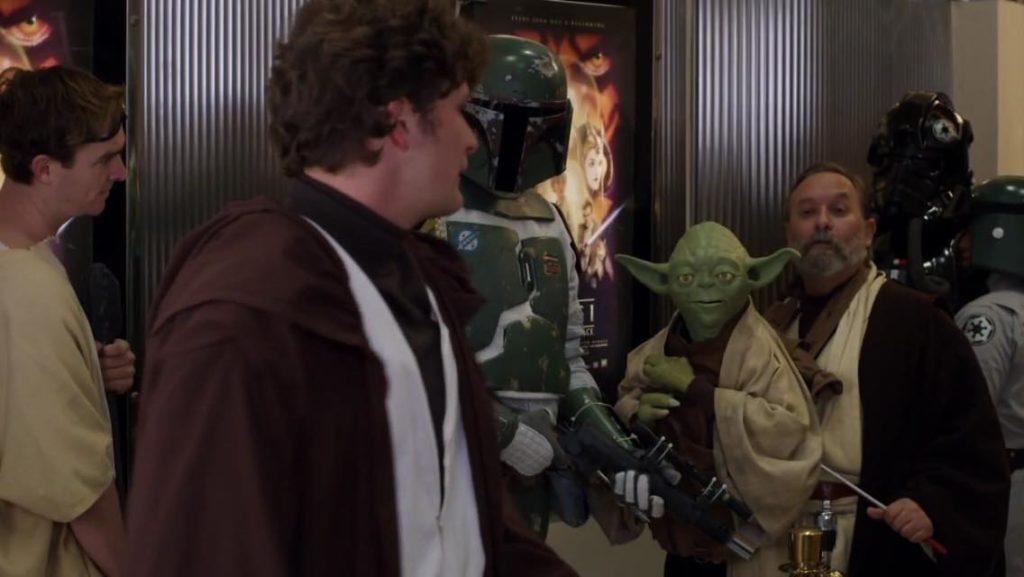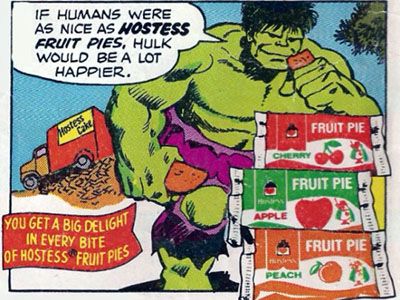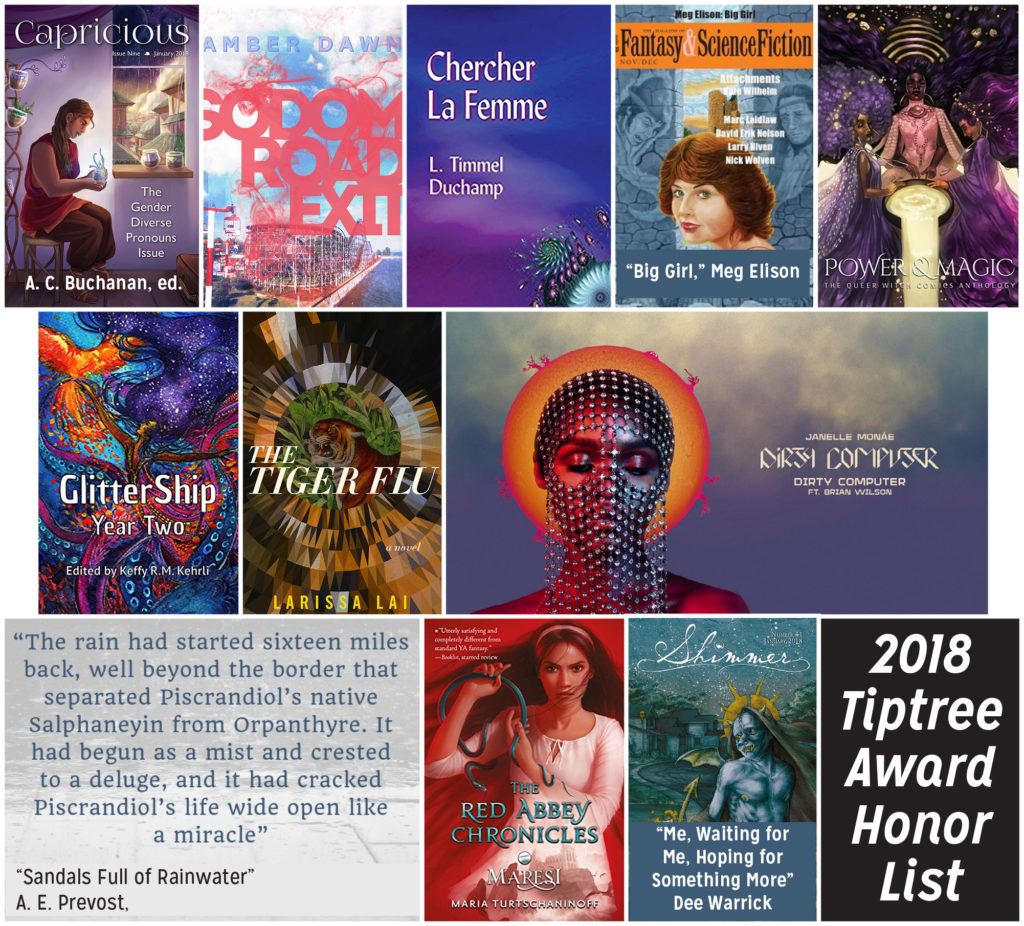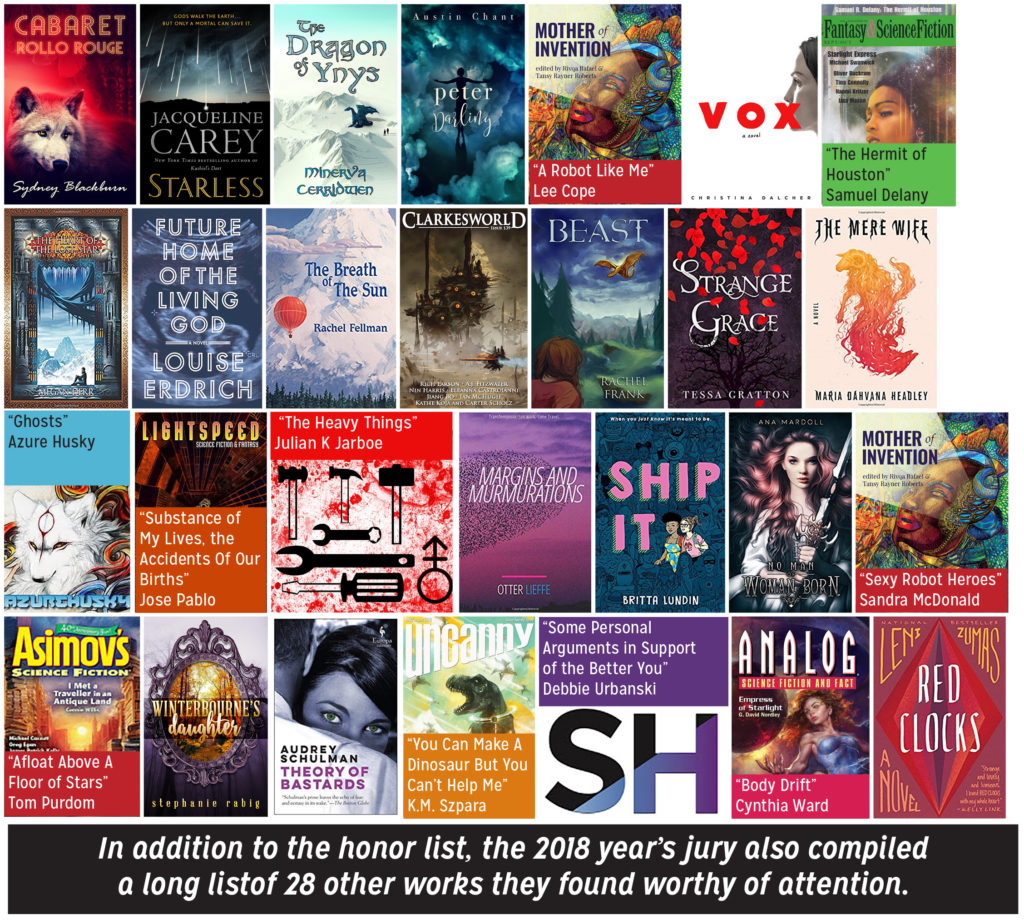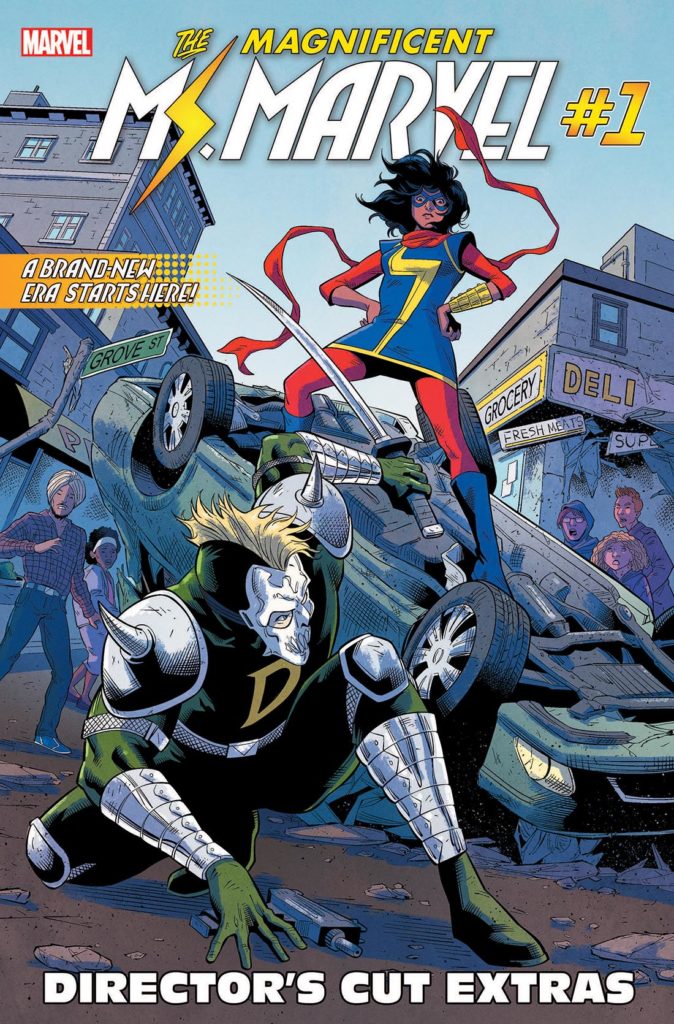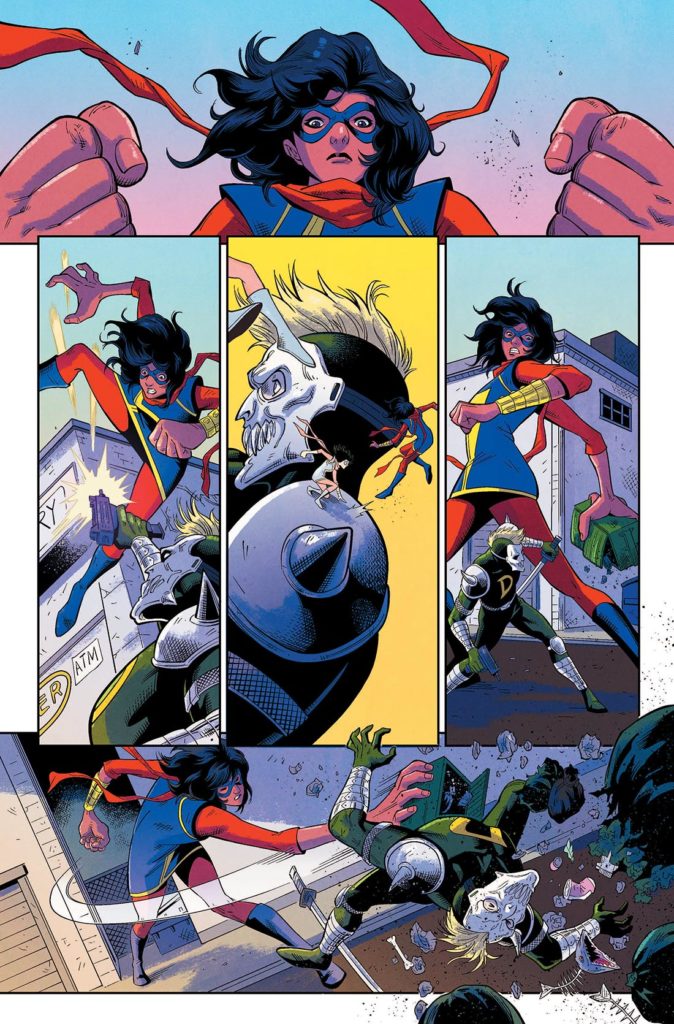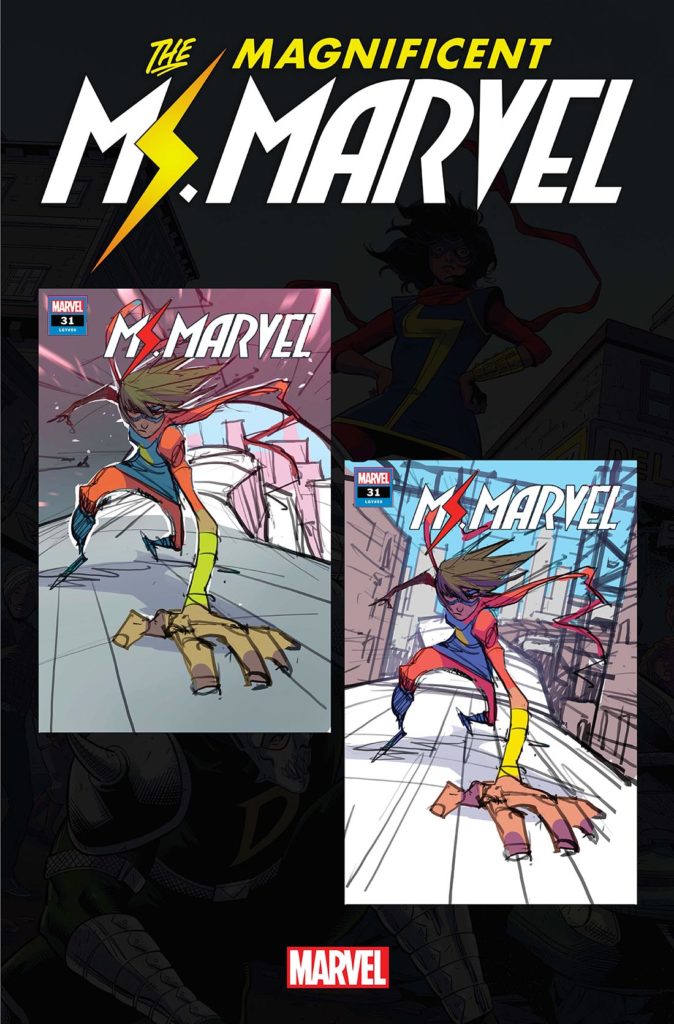(1) COSPLAY. SYFY Wire shares a photo gallery: “Pokémon and Spider-Verse cosplay highlight Day 1 at C2E2 2019”.
Video games were well represented with Halo and Detective Pikachu complimenting the various Mario Bros. sticking up for the nostalgic. Various superheroines ran around with plenty of well-costumed anime heroes and it was all as exciting (and packed) as an Avengers film.
(2) FEAR ITSELF. Ethan Mills reveals his “Non-Spoilery Impressions of Jordan Peele’s Us” at Examined Worlds.
Is Us scary? Sure, but not as much in a straightforward horror sense as you might think. There aren’t a lot of jump scares. There are no scary clowns or zombies or vampires or ghosts or whatever. But it’s horror in a deeper sense. It’s supposed to communicate directly with something deep inside the viewer and stay there, lurking in both your conscious and unconscious mind. It’s a mirror that allows you to see that you’ve been there staring at yourself the whole time.
(3) SETTING THE RECORD STRAIGHT. Ellen Datlow responded to S.T. Joshi on Facebook.
This is very tiresome. I know I should let sleeping dogs lie, but I don’t like being called a liar, especially in print, and even more especially by someone who seems ignorant of how things actually work.
S. T. Joshi claims I was the “prime mover” behind the change in the WFA bust. I was not. I was/am a member of the Awards Administration that decided it was time for a change.
He further claims he was told by “a member of the committee” that there was no vote taken to change the award.
#1 there is no such thing as the World Fantasy Committee. There is a World Fantasy Convention Board and there is an Awards Administration. Perhaps he is confusing the two.
#2 I am a member of the Awards Administration and a voting member–only of the AA. At the time there were six of us.
#3 I am on the overall WFC board board itself as a non-voting member.
#4 The entire WFC board under David Hartwell voted unanimously to change the award. There were no nays and as far as I can remember there were no abstentions.
I would be happy to know who the person is that claims there was no vote taken because there is likely a record recording (or at least acknowledging) the vote.
(4) GRAVITY INDUSTRIES DEMO. The Chicago Tribune posted video of “Jet suit flight at Museum of Science and Industry”.
In the future, we have been promised, there will be jet packs. Usually this is said with disappointment. But on the front steps and lawn of Chicago’s Museum of Science and Industry this week, there actually was a working jet suit, and a man brave enough to get in and buzz around. Inventor Richard Browning, a British former oil trader, was showing off his invention to promote the museum show, “Wired to Wear,” that features the suit from his Gravity Industries and scores of other examples of cutting-edge wearable tech.
(5) FIREFLY. More on the Disney/Fox merger’s princess implications for the women in Firefly.
(6) A HEAP OF GLORY. Gizmodo has discovered “Where Movies Get Their Vintage Electronics”.
Have you ever watched a show like Mad Men and wondered where they found those early Xerox machines? Or where The Americans got their hands on all the Reagan-era IBMs that you thought would be piled in a landfill? Well, there’s a good chance these historically-accurate gadgets came from a massive warehouse in Brooklyn with a specific mission: to preserve some of the world’s oldest, most cherished electronics.
(7) TODAY’S BIRTHDAYS.
[Compiled by Cat Eldridge.]
- Born March 24, 1834 — William Morris. Credited with creating the modern fantasy literature genre, he certainly wrote some of it its earlier works, to note his epic poem The Earthly Paradise, The Wood Beyond the World and The Well at the World’s End, plus his entire artistic motif fits nearly within a fantasy literature as it looks as if it was created by the Fey Themselves. (Died 1896.)
- Born March 24, 1874 — Harry Houdini. Yes, him. He wrote “The Spirit Fakers of Hermannstadt” which had its first half published in March 1924 issue of Weird Tales. An issue of that sold at an auction aimed at Houdini collectors for $2,500 on eBay fetching 43 bids. (Died 1926.)
- Born March 24, 1897 — Theodora Kroeber. Another one of those women with an amazing full name, to wit Theodora Covel Kracaw Kroeber Quinn, she’s the mother of Ursula Kroeber Le Guin. She’s here because ISFDB insists that she wrote a genre novel by the name of Carrousel. Well it’s a novella actually at ninety-one pages and might or might not be genre. If anyone’s read it, they can tell me what it is. (Died 1979.)
- Born March 24, 1946 — Gary K. Wolfe, 73. Monthly reviewer for Locus for 27 years now and, yes, I enjoy his column a lot. His brief marriage to Ellen R. Weil which ended with her tragic early death resulted in them co-writing Harlan Ellison: The Edge of Forever. Old Earth Books has reprinted many of his reviews done between 1992 and 2006. He’s also written several critical looks at the genre, Critical Terms for Science Fiction and Fantasy and The Known and the Unknown: The Iconography of Science Fiction.
- Born March 24, 1949 — Tabitha King, 70. Wife of Stephen, mother of that writing brood. I met her but once on the lot of the original Pet Sematary a very long time ago. ISFDB to my surprise lists only two novels she’s written solely by herself, Small World and Wolves at the Door, and one with Michael McDowell, Candles Burning. None with her husband.
(8) COMIC SECTION.
- Pearls Before Swine today has a questionable solution to our country’s problems.
- Evidently JDA spent the most recent St. Patrick’s Day communing with The Little People. He hopes they’ll give him lots of green.
(9) FOLLOW THE YELLOWING PAGE ROAD. That pulp fiction we’ve all been talking about? Open Culture says you can find a lot of it here: “Enter the Pulp Magazine Archive, Featuring Over 11,000 Digitized Issues of Classic Sci-Fi, Fantasy & Detective Fiction”.
There’s great science fiction, no small amount of creepy teen boy wish-fulfillment, and lots of lurid, noir appeals to fantasies of sex and violence. Swords and sorcery, guns and trussed-up pin-ups, and plenty of creature features. The pulps were once mass culture’s id, we might say, and they have now become its ego.
(10) BOOK VS. MOVIE. Steve Fahnestalk digs deep into the DVD bin for his “’Historic’ Film Review: King Solomon’s Mines (1937)” – at Amazing Stories.
Quatermain’s companions (Commander Good—Roland Young; and Sir Henry Curtis—John Loder), who have paid him to be a guide on their African hunting trip, tell him they want to pursue O’Brien; Umbopo tells them he knows the country because he was from there originally. They end up in a desert region and have to abandon the wagon because the oxen can drink up all their water in no time at all. So they head off, following the map, onto the “burning sands” on foot. (In the book, Quatermain, who’s been an elephant hunter for years, knows better, and they go only at night in the desert.) Umbopo sings them on their way (Robeson was, at this point, an international star—his “Old Man River” was the hit of the British version of Showboat—and he’s actually got the biggest credit; this film is a vehicle for him, rather than just an attempt to film Haggard’s book.)
(11) XO4K. BBC reports “Exoplanet tally set to pass 4,000 mark”.
The number of planets detected around other stars – or exoplanets – is set to hit the 4,000 mark.
The huge haul is a sign of the explosion of findings from searches with telescopes on the ground and in space over the last 25 years.
It’s also an indication of just how common planets are – with most stars in the Milky Way hosting at least one world in orbit around them.
That’s something astronomers couldn’t be certain of just 30 years ago.
(12) PRESERVED JELLIES. Rare finds near the Danshui river: “Huge fossil discovery made in China’s Hubei province”.
Scientists say they have discovered a “stunning” trove of thousands of fossils on a river bank in China.
The fossils are estimated to be about 518 million years old, and are particularly unusual because the soft body tissue of many creatures, including their skin, eyes, and internal organs, have been “exquisitely” well preserved.
Palaeontologists have called the findings “mind-blowing” – especially because more than half the fossils are previously undiscovered species.
The fossils, known as the Qingjiang biota, were collected near Danshui river in Hubei province.
(13) GOAL MODELS. “The greatest strong female characters of all time” is another list/opinion piece from SYFY Wire’s Fangrrls.
In the entirety of its existence, the majority of sci-fi, fantasy and horror works have centered men — usually straight, white ones. It is then perhaps all the more impressive that the most powerful, inspirational characters across genre are women. While there is still a long way to go to make genre less white, less cis and less able-bodied, we are grateful for the women who showed us that genre isn’t just for “boys” and that not all heroes are male.
Jenna Busch picked –
Lessa
Lessa from Anne McCaffrey’s Dragonriders of Pern series embodies the true strong female character. Even better? It was written back in the late ’60s when SFCs were few and far between. Lessa survived in awful conditions as a child, was chosen as the last Dragonrider of a Queen, ensuring the survival of the creatures. She defied conventions and helped prepared for the return of the deadly Threadfall, traveled 400 years back in time to bring forward other Dragonriders to help and stood strong against the very male-dominated society she lived in. OK, maybe her time travel did sort of form a paradox that caused the deficit in Dragonriders to begin with, but hey, she couldn’t know that, could she? Lessa took no crap from anyone, was proud of her no bull policy and is the perfect example of someone defined by the Shakespeare quote, “And though she be but little, she is fierce.” –
(14) THINK UP, PLEASE! Around 75% accuracy is claimed: “Neuroscientists Have Converted Brain Waves Into Verbal Speech” – Smithsonian has the story.
The team’s research, published in Scientific Reports, involves a somewhat unconventional approach. Rather than directly tracking thoughts to produce speech, the researchers recorded neurological patterns generated by test subjects listening to others speak. These brain waves were fed into a vocoder—an artificial intelligence algorithm that synthesizes speech—and then converted into comprehensible, albeit robotic-sounding, speech mirroring the phrases heard by participants.
(15) A KINGDOM OF ONE. [Item by Mike Kennedy.] At the top level, life is divided into three domains bacteria, archae, and eukaryotes—the latter having cells in which the genetic material is DNA in the form of chromosomes contained within a distinct nucleus. Eukaryotes are divided into several kingdoms, typically Animalia (animals), Plantae (plants), Fungi, and Protista—the latter of which is something of a catch-all category. (It should be noted that a number of other division schemes exist.)
A new DNA analysis of creature called hemimastigotes—firmly in the domain of eukaryotes given their cellular structure—says they are so different from the four eukaryote kingdoms (even the catch-all Protista) that they should be their own kingdom (CBC News: “Rare microbes lead scientists to discover new branch on the tree of life”). The original source (Nature: “Hemimastigophora is a novel supra-kingdom-level lineage of eukaryotes”) is behind a paywall, but the CBC News article notes:
Two species of the microscopic organisms, called hemimastigotes, were found in dirt collected on a whim during a hike in Nova Scotia by Dalhousie University graduate student Yana Eglit.
A genetic analysis shows they’re more different from other organisms than animals and fungi (which are in different kingdoms) are from each other, representing a completely new part of the tree of life, Eglit and her colleagues report this week in the journal Nature.
“They represent a major branch… that we didn’t know we were missing,” said Dalhousie biology professor Alastair Simpson, Eglit’s supervisor and co-author of the new study.
“There’s nothing we know that’s closely related to them.”
In fact, he estimates you’d have to go back a billion years — about 500 million years before the first animals arose — before you could find a common ancestor of hemimastigotes and any other known living things.
(16) ONCE AND FUTURE. VickyWhoReads praises this reworking of the Arthurian legend: “Once & Future by Amy Rose Capetta & Cori McCarthy: An Underhyped, Genderbent King Arthur Retelling in Space!”
I think something that I forget to think about with books is just how much they appeal to readers outside of pure entertainment. The cast of characters is so diverse—and in a futuristic space setting, it’s just a big bundle of inclusivity. (Except for the bad corporations, but even then, there’s not really discrimination based on sex/religion/race/etc., it’s “oh look people rebelling, let’s kill them.”)
And, frankly, it was a really refreshing read in the way that I didn’t have to watch people suffer based on who they were, we got to watch them suffer because they were fighting evil corporations. (Not to say that books that do show this are bad, but this was a nice moment where I could just bury myself under all the openly queer characters and accepting nature of everyone in the novel.)
Ari & Gwen are bi or pan, Lam is fluid, Merlin is gay, and Jordan is ace so we get to see a whole giant cast of queer characters, and no one suffering because of their queerness! It was wonderful and just really refreshing.
(17) ICONIC MOMENTS. About half the scenes in Vanity Fair’s collection of “The 25 Most Influential Movie Scenes of the Last 25 Years” are from genre/adjacent movies.
Sometimes, all it takes is a single scene to change moviemaking for good. (“Rosebud . . .” comes to mind.) And while many of the last quarter-century’s films have awed, inspired, and offered up iconic entries into the cultural canon, only some—and particularly, only a few individual moments—have genuinely influenced how future films were made. So, what makes that list? To mark the 25th edition of the Hollywood Issue, Vanity Fair’s film critics pinpointed 25 film scenes since 1995 that changed the industry, the art form, and even the culture, and our reporters spoke to the performers and filmmakers who made them happen.
- Toy Story
- Scream
- The Matrix
- The Blair Witch Project
- Crouching Tiger, Hidden Dragon
- The Lord of the Rings: The Two Towers
- Star Wars: Episode III—Revenge of the Sith
- Children of Men
- Iron Man
- The Dark Knight
- Twilight
- Get Out
(18) SIBLINGS. Paul Weimer tells why he largely enjoyed this fantasy novel: “Microreview [book]: The Sisters Mederos by Patrice Sarath” at Nerds of a Feather.
House Mederos has seen better times. Much better times. After the sinking of a fleet, that may have been secretly the doing of the younger of the Mederos sisters, the family is impoverished and cast out of the society of Port Saint Frey. Yvienne and Tesara spent years in a horrid boarding school for the impoverished. But now they have returned, and now have the opportunity, as they try to help their family recover their fortunes. House Mederos has been reduced to near penury, but that status will not remain forever if the sisters have anything to do about it. Even if it takes questionable acts, in ballrooms and nightly doings alike, to accomplish the feat.
(19) THREE DIMENSIONS. The Weatherwax Report’s Esme, Coffee, and Kristen collaborate on areview of another indie fantasy work — “SPFBO Finalist: Ruthless Magic by Megan Crewe”. Esme begins —
The main characters are young, but they aren’t whiny or angsty which is why I think this one clicked. I liked seeing diversity in the characters with both an LGBT side character and a Hispanic main character – I don’t see either of those represented often in fantasy. This was a quick book that I read in a sitting, the writing was straight forward and sped the story along, so it earned high marks in pacing.
[Thanks to Martin Morse Wooster, John King Tarpinian, Cat Eldridge, Daniel Dern, Chip Hitchcock, JJ, Mlex, Mike Kennedy, Carl Slaughter, and Andrew Porter for some of these stories. Title credit goes to File 770 contributing editor of the day Kurt Busiek.]
[Update 03/26/19: Removed Andrew Porter’s birthday listing.]



